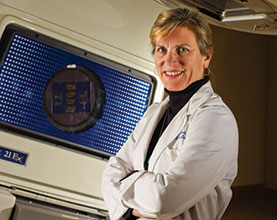Sep 27, 2011
 | |
| COURTESY OF SHAW REGIONAL CANCER CENTER |
The idea for Chartrounds (chartrounds.com) was born from Dr. Hardenbergh’s own experience moving from Duke University Medical Center to a solo practice at Shaw Regional Cancer Center. She developed an online professional relationship with colleagues at the University of Colorado to discuss cases and share best practices, in order to provide the patients in her community practice with the best possible care. She realized that other community practitioners could benefit from such collaboration with each other and with their colleagues at academic centers.
“I’m so grateful to the Conquer Cancer Foundation, Komen, and ASCO for giving me the opportunity to demonstrate something that was incredibly successful in my practice and to offer that to other community physicians throughout the United States,” she said.
With support from the Improving Cancer Care Grant, Dr. Hardenbergh and her team developed a user-friendly web portal to host live discussions of real patient cases. The pilot program was limited to breast cancer; given the success of those sessions and feedback from Chartrounds members, the site now includes discussions of head and neck cancers, gastrointestinal malignancies, and lung cancer. Future disease sites will include central nervous system, prostate, and gynecologic cancers.
“There was such a need for the level of the questions that were answered that both head and neck sessions went over their allotted hour. It’s remarkable to see the level of dedication from the participants and the disease-specific experts, who are deciding to spend an hour or two away from the clinic because they know that the discussions will lead to better care for their patients,” Dr. Hardenbergh said.
Today, 170 members in 47 states participate in Chartrounds, with 38 sessions completed in the first seven months after the site launched. Following each session, there is a short evaluation which asks participants how likely they are to make changes in their practice based on the information shared on a scale of 0 to 5, with 5 being the most likely—the average score for the response is 4.4.
“There is a very strong message that Chartrounds is meeting a need in the community to have access, at the level of case presentation, to professionals who have dedicated their careers to disease sites. The sessions are very powerful; the discussions are rich and provocative,” Dr. Hardenbergh said. “This project goes beyond dose recommendations to a technical level of peer review that has not been widely available in the past to community oncologists.”
As Chartrounds continues to grow and evolve, Dr. Hardenbergh hopes to bring a clinical trials component to the program. In the future, she would like to establish an easy-to-use trial database within the Chartrounds site and involve a clinical trials associate to support community oncologists who would like to help their patients enroll in trials.
“Oncologists want the practice of oncology to move forward with clinical research, but there are certainly barriers to doing so in a community setting, including ease of use and budget. In my own experience in a community practice, I’ve had difficulty utilizing some of the clinical trials resources that are currently available. In the future we’d like to make it easier for physicians to find information about trials, and make it easier for them to enroll their patients, and we see a real opportunity in the Chartrounds project,” Dr. Hardenbergh explained.
